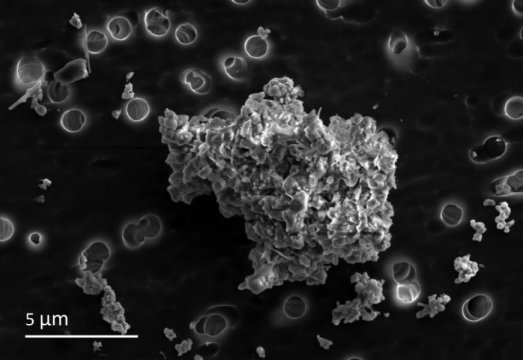[ad_1]
Note: This press release was adapted from an original release by the University of Hawaii at Manoa in Honolulu.
Experiments conducted at the Department of Energy’s Lawrence Berkeley National Laboratory (Berkeley Lab) helped to confirm that samples of interplanetary particles — collected from Earth’s upper atmosphere and believed to originate from comets — contain dust leftover from the initial formation of the solar system.
An international team, led by Hope Ishii, a researcher at the University of Hawaii at Manoa (UH Manoa), studied the particles’ chemical composition using infrared light at Berkeley Lab’s Advanced Light Source (ALS). Scientists also explored their nanoscale chemical makeup using electron microscopes at the Lab’s Molecular Foundry, which specializes in nanoscale R&D, and at the University of Hawaii’s Advanced Electron Microscopy Center.
The study was published online June 11 in the journal Proceedings of the National Academy of Sciences.
The initial solids from which the solar system formed consisted almost entirely of carbon, ices, and disordered (amorphous) silicate, the team concluded. This dust was mostly destroyed and reworked by processes that led to the formation of planets. Surviving samples of pre-solar dust are most likely to be preserved in comets — small, cold bodies that formed in the outer solar nebula.
In a relatively obscure class of these interplanetary dust particles believed to originate from comets, there are tiny glassy grains called GEMS (glass embedded with metal and sulfides) that are typically only tens to hundreds of nanometers in diameter, or less than a hundredth of the thickness of a human hair. Researchers embedded the sample grains in an epoxy that was cut into thin slices for the various experiments.
Using transmission electron microscopy at the Molecular Foundry, the research team made maps of the element distributions and discovered that these glassy grains are made up of subgrains that aggregated together in a different environment prior to the formation of the comet.
The nanoscale GEMS subgrains are bound together by dense organic carbon in clusters comprising the GEMS grains. These GEMS grains were later glued together with other components of the cometary dust by a distinct, lower-density organic carbon matrix.
The types of carbon that rim the subgrains and that form the matrix in these particles decompose with even weak heating, suggesting that the GEMS could not have formed in the hot inner solar nebula, and instead formed in a cold, radiation-rich environment, such as the outer solar nebula or pre-solar molecular cloud.
Jim Ciston, a staff scientist at the Molecular Foundry, said the particle-mapping process of the microscopy techniques provided key clues to their origins. “The presence of specific types of organic carbon in both the inner and outer regions of the particles suggests the formation process occurred entirely at low temperatures,” he said.
“Therefore, these interplanetary dust particles survived from the time before formation of the planetary bodies in the solar system, and provide insight into the chemistry of those ancient building blocks.”
He also noted that the “sticky” organics that covered the particles may be a clue to how these nanoscale particles could gather into larger bodies without the need for extreme heat and melting.
Ishii, who is based at the UH Manoa’s Hawaii Institute of Geophysics and Planetology, said, “Our observations suggest that these exotic grains represent surviving pre-solar interstellar dust that formed the very building blocks of planets and stars. If we have at our fingertips the starting materials of planet formation from 4.6 billion years ago, that is thrilling and makes possible a deeper understanding of the processes that formed and have since altered them.”
Hans Bechtel, a research scientist in the Scientific Support Group at Berkeley Lab’s ALS, said that the research team also employed infrared spectroscopy at the ALS to confirm the presence of organic carbon and identify the coupling of carbon with nitrogen and oxygen, which corroborated the electron microscopy measurements.
The ALS measurements provided micron-scale (millionths of a meter) resolution that gave an average of measurements for entire samples, while the Molecular Foundry’s measurements provided nanometer-scale (billionths of a meter) resolution that allowed scientists to explore tiny portions of individual grains.
In the future, the team plans to search the interiors of additional comet dust particles, especially those that were well-protected during their passage through the Earth’s atmosphere, to increase understanding of the distribution of carbon within GEMS and the size distributions of GEMS subgrains.
[ad_2]















